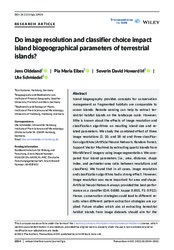Do image resolution and classifier choice impact island biogeographical parameters of terrestrial islands?
DOI: https://doi.org/10.1111/tgis.12920
Persistent URL: http://resolver.sub.uni-goettingen.de/purl?gldocs-11858/10261
Persistent URL: http://resolver.sub.uni-goettingen.de/purl?gldocs-11858/10261
Oldeland, Jens; Eibes, Pia Maria; Irl, Severin David Howard; Schmiedel, Ute, 2022: Do image resolution and classifier choice impact island biogeographical parameters of terrestrial islands?. In: Transactions in GIS, Band 26, 4: 2004 - 2022, DOI: 10.1111/tgis.12920.
 |
Dokument öffnen: |
Island biogeography provides concepts for conservation management as fragmented habitats are comparable to ocean islands. Remote sensing can help to extract terrestrial habitat islands on the landscape scale. However, little is known about the effects of image resolution and classification algorithms on resulting island size and related parameters. We study the combined effect of three image resolutions (2, 10, and 30 m) and three classification algorithms (Artificial Neural Network, Random Forest, Support Vector Machine) by extracting quartz islands from WorldView‐2 imagery using image segmentation. We compared four island parameters (i.e., area, distance, shape index, and perimeter–area ratio between resolutions and classifiers). We found that in all cases, image resolution and classification algorithms had a strong effect. However, image resolution was more important for area and shape. Artificial Neural Network always provided the best performance as a classifier (OA: 0.880, kappa: 0.801, F1: 0.912). Hence, conservation strategies could lead to different results when different pattern extraction strategies are applied. Future studies which aim at extracting terrestrial habitat islands from image datasets should aim for the highest possible resolution and compare the outcomes of different classifiers to ensure the best possible results.
Statistik:
ZugriffsstatistikSammlung:
- Geographie, Hydrologie [454]
Schlagworte:
South AfricaKnersvlakte bioregion
quartz islands
image segmentation
classification algorithms
This is an open access article under the terms of the Creative Commons Attribution‐NonCommercial‐NoDerivs License, which permits use and distribution in any medium, provided the original work is properly cited, the use is non‐commercial and no modifications or adaptations are made.

